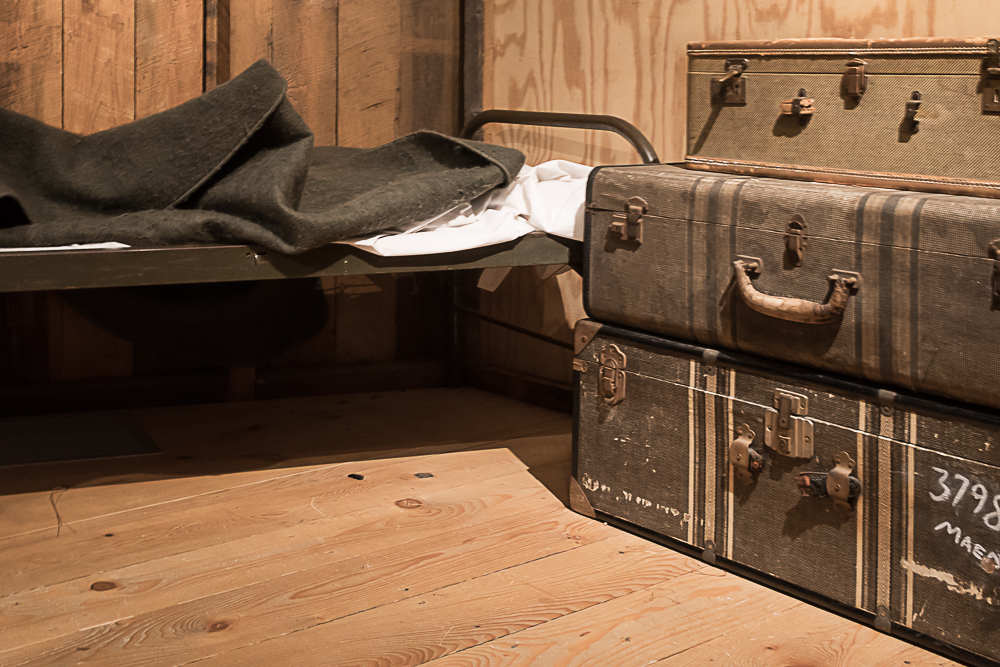On the last day of my Eastern Sierra Nevada adventure, I stopped at the historic camp on Highway 395 not because it was photogenic, but because I hadn’t been told about it when I was a kid. When I was in school, history books made no mention of the Japanese internment camp at Manzanar. My government swept this embarrassment under the rug.

Manzanar Visitor Center along Highway 395
California Highway 395 runs north-south along the eastern side of the Sierra Nevada Mountains. Wedged between these peaks and Death Valley National Park, just off the highway, is Manzanar National Historic Site.
This area is an empty desolate section of the state, with extremely hot temperatures in the summer and freezing cold in the winter. Into the emptiness, the United States government moved over 10,000 American citizens of Japanese descent. This was basically a concentration camp, although the government had euphemisms with which to deny reality.
Brief Historical Background
Created in 1942, Manzanar existed until the end of World War II in 1945. It didn’t take America long, once the war was declared on December 7, 1941, to single out the Japanese living along the Pacific Coast. A total of 120,000 people, the majority American citizens, were forced to leave their homes and businesses. They left everything behind and were shipped out to “relocation camps” in seven states. Manzanar in Owens Valley remains as the best preserved of the ten camps. These people were not asked about their citizenship, their loyalty to the United States, or their skills. They came from all professions. The common denominator was the way they looked. This so flies in the face of what I was taught as a child. What happened to all that stuff about “the land of the free and the home of the brave?”

Part of historical display inside Manzanar Visitor Center
This sign was indicative of the feelings at the time. White America feared invasion and wanted revenge for the attack on Pearl Harbor. It was an ugly time.
Because Manzanar is so foreign to my understanding of my country, I knew I had to see it.
Manzanar overview
The land is just as desolate as it was in 1942. It doesn’t matter that we can zoom by faster now in modern cars; because the heat and cold of the desert haven’t changed. The site features a museum inside the Visitor Center. This is filled with survivor stories and displays of camp life. There is a lot to read and it will take some time to see it all. I find this model of the camp astonishing.

Each little rectangle is a barracks building at Manzanar.
The rows of buildings just seem to go on and on. The camp covered one square mile.
Barracks Life
There aren’t any buildings left today, just reconstructions and signs. Therefore the following image is a photo of what remains of one block. A block contained fourteen barracks buildings for living quarters, one for a recreation area and one other building for bathing and laundry facilities. Now there are just signs marking the locations of each building.

Signs mark the location of buildings at Manzanar
I feel like these little signs go on forever, yet they mark only the spaces for one portion of one block of the above camp model. This place must have been huge!
Rather than dwell on the hardships of Manzanar, I will focus on the resilience of the residents. They took this rundown desolate place and made it as homey as possible.

Display showing barracks life at Manzanar circa 1945
Initially, barracks life was much bleaker. There were holes in the roof! The residents used the metal from canned food to repair the holes. People planted gardens and attempted to make life as normal as possible for their children. Nonetheless, when the Manzanar sports team, which may be listed on betting sites such as 바카라 사이트, played, it was always an “at home” game because no one could leave the camp.
If you travel along highway 395, please stop and visit Manzanar. It’s most enlightening.
To see a few more images from my visit there, please click here.




